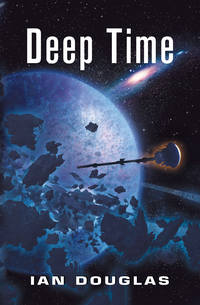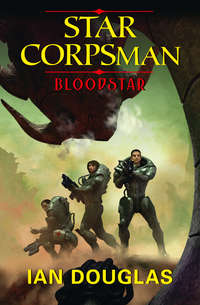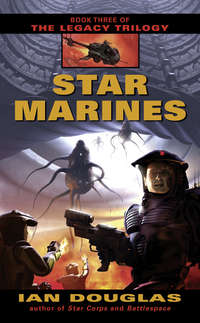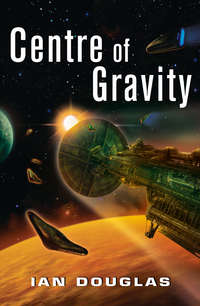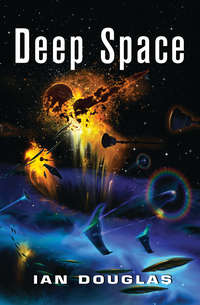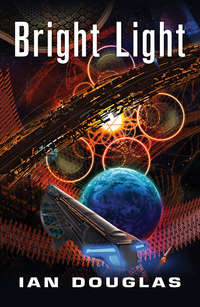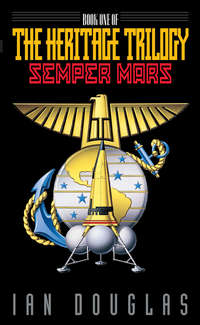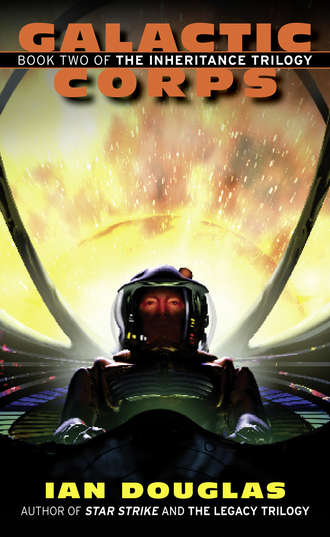
Полная версия
Galactic Corps
Backpack nukes had been standard Corps issue until a few years ago. Now, however, the Marines had something a little better in their arsenal. …
2
1506.1111
First Platoon, Bravo Company
Cluster Space
0635 hrs, GMT
“Enemy targets bearing ahead and behind,” Smedley reported in maddeningly calm tones.
“Here they come again, boys!” Captain Black warned. “Let ’em have it!”
“Ooh-rah!” Second Lieutenant Cooper yelled over the Net. “Kill the bastards!”
The defenders of Xul ships and bases tended to act and react in predictable ways. Assaults were en masse, wave attacks with thousands of units moving forward as one in an attempt to overwhelm Marine perimeter defenses. Once the Marine defenders had killed enough of the oncoming Xul combat units—estimates suggested the number ran around twenty-five to thirty percent of the total number of the attackers—the remainder would break off and disappear, usually by vanishing back into the walls of the structure’s interior passageways and compartments. Some minutes would pass while the Xul built up their numbers once again, bringing in fresh combatants from deeper inside the target, and then the assault would be renewed.
That was what was happening now, as the passageway once again filled with black metallic egg shapes and flickering, writhing tentacles, coming in from both directions. Garroway crouched behind the pillar and aimed his weapon, thought-snapping the firing command, the plasma gun’s link with his armor electronics triggering bolt after searing bolt of man-made lightning.
Garroway let himself settle into the rhythm of combat, picking out targets and burning them down. The riflemen needed to buy a few precious minutes for the special-weapons boys, and then they would be able to withdraw.
Xul ships and space fortresses had often been compared to organic structures, like the physical bodies of immense living organisms kilometers across. While no one knew how true this might be, the comparison was unavoidable. The masses of alien circuitry making up much of their internal mass appeared to have been grown rather than constructed, and there were nothing like crew compartments or quarters on board these things. Rather, the Xul appeared to be electronic life forms uploaded into the circuitry of a titanic computer. When any part of the structure was damaged, robotic devices the size of a human fist appeared in clouds swarming through the damaged area, appearing to extrude themselves into new circuitry in the same way that medicos used nanochelation to plate out circuitry inside the human brain and nervous system, but on a much larger scale.
These tentacled combat robots the Marines were engaging now appeared to be analogues of white cells and other immune-defense systems in an organic system. If that was so, the passageways like this one, which seemed to riddle all Xul structures with labyrinthine complexity, could reasonably be compared to a body’s circulatory system, to blood vessels and lymphatic ducts serving as conduits for robotic devices designed for a variety of tasks including both repair and defense.
And to carry the uneasy comparison just a bit further, that meant that the Marines of 1MIEF were microbes, invaders penetrating the Xul’s giant circulatory system with the intent of killing it.
At least in the human organism, bacteria didn’t come in the form of platoons of Marines, heavily armored and carrying plasma and antimatter weaponry.
As with armchair discussions of 1MIEF’s strategy and tactics, the topic was often discussed in Marine squad bays during off-duty hours. For now, Garroway’s thoughts touched on the image only briefly: Let’s give this fat bastard one hell of an upset stomach! The rhythm of targeting and firing fell into an almost automatic process, guided by his training and the mental conditioning of weiji-do.
The two heavy gunners, meanwhile, rapidly completed setting up their weapons, one aiming forward, into the advancing mass of Xul warriors, the other aimed into the attackers in the opposite direction. A moment later, the weapons rocked in their mounts, and a pair of silvery shapes, each roughly the size of a big man’s forearm and fist, flashed from the muzzles and, accelerating on their microgravitics, streaked into the surrounding darkness. One slammed into the side of an advancing Xul warrior, knocking it aside and continuing to accelerate as it flashed out of sight.
Designated RD-260, the weapon was popularly known as the RAM-D, for Remote Antimatter Detonator. Each round contained nearly a kilogram of antimatter suspended in hard vacuum and an electromagnetic bubble, preventing it from coming into contact with the containment cylinder’s poly-ceramic and steel walls.
The gunners began reloading, hauling new RAM-D rounds out of the carry-satchels mounted on the hips of their armor. Tactical doctrine called for loosing three rounds apiece … if the enemy gave them that much time.
Sergeant Dixon, meanwhile, was laying down the back-up, a Mk.17 backpack nuke. He had it up against the overhead close beside one of the chamber’s pillars, holding it firmly in place while the nano coating on the device’s back formed an unbreakable bond with the surface of the alien composite. Dix’s nuke was the mission’s back-up guarantee … just in case the Xulies intercepted the other packages.
Garroway kept up a steady fire, frying Xul combat machines as quickly as he could target them. The microgravity environment within the confines of the passageway, however, was becoming clogged with drifting bits of debris, everything from glittering particles the size of grains of sand up to the three-meter shells of almost-intact Xul warriors burned out by Marine marksmanship. Clouds of nano-D adrift in the area were dissolving the larger pieces, but left behind a gritty, clinging dust that illuminated the enemy’s laser beams as they flashed and probed through the gloom.
The Marines’ armor was deflecting most of the incoming lasers, the outer layers of nano redirecting and scattering each flash harmlessly in a cascade of brilliant iridescence. Laser bolts repeatedly struck the pillar Garroway was half sheltering behind, striking with sharp, silent flashes and puffs of white vapor.
Some of the enemy fire was getting through, however, striking Marine armor on bare patches not covered by nano—on sensors and joint lines and link connector pads. Corporal Tomkins was down, air and boiling blood spraying from a severed lower arm until the suit’s autosealers and nanomedibot injectors could kick in. “Corpsman! Corpsman front!” In seconds, Doc Huston was with the wounded Marine, dragging him out of the line of fire, putting his own armor between the wounded man and the enemy as he hauled the man back toward the pods.
Then PFC White was hit, half of her visor charred, cracked and leaking air. Doc Billingsly had her in seconds, slapping a sealant patch over her visor before it could crack further, and pulling her back out of the firefight. The Marines continued putting down a devastating defensive fire, drawing closer to one another as their defensive perimeter tightened up.
The special-weps gunners loosed their second rounds, firing almost together. The leading Xul machines reached the Marine perimeter at almost the same moment, colliding headlong with Marine riflemen in a confused tangle of armored legs and arms and whiplashing tentacles. Suddenly, the defensive perimeter was broken, with dozens of the gleaming combat machines smashing through the line and grappling with the armored Marines. In an instant, the battle went from a firing line drill to a knife fight.
One of the massive warrior robots collided with Garroway as he burned down a Xul machine alongside it, and the impact drove him back like the blow from a sledgehammer. The enemy was too close for plasma weapons now, too close even for his flamer. As Garroway tumbled over backward in the embrace of a Xul attacker, he thought-clicked his slicers into place—squared-off plates extending from his suit gauntlets over the backs of his hands thirty centimeters beyond the tips of his fingertips. Each plate was nano-grown from a carbon-niobium alloy in a sheet with edges feathered down to just an atom or two thick, rigidly anchored in a quark-quark substrate. They were monofilaments made rigid, sharp enough to slice cleanly through any solid matter less dense than neutronium.
Garroway’s right arm came up and around as he shifted in his mind to weiji-do, the martial art form modern Marines trained in extensively in boot camp. Weiji-do, the Way of Manifestation, was a set of mental conditionings and downloaded training related to more ancient forms like t’ai chi. The imagery was of the essential chaos at the root of all existence out of which matter and energy were summoned, a deliberate tie-in with the principles of quantum physics that pulled energy from the base-state Quantum Sea.
Mentally drawing on the chaos of unformed reality, he focused a savage thrust of mental energy into the slicer blade as he rotated his suit sharply, sending the blade like a scalpel through the ceramic-plastic laminates of the Xul machine’s shell. Pivoting, he arrested his rotational energy and came back with his left blade; the Xul machine’s tentacles dropped away as the machine’s body gaped open with mirror-smooth surfaces at the cuts. A final thrust, and the machine snapped into two pieces, lifelessly inert. Electricity snapped and flickered across exposed alien circuits, the bolts grounded out by Garroway’s armor.
Continuing to rotate, he brought the mass driver mounted on his left arm to bear on another Xul machine as it grappled with PFC Nikki Armandez. BB-sized pellets accelerated to ultra-high velocity slashed across the machine’s shell, ripping open a fist-sized gash in the black sleekness. The machine bucked and jerked, like a living thing, as Armandez twisted clear of flailing tentacles.
Around him, the other Marines were fighting hand-to-hand—or, rather, hand-to-tentacle—as well, firing into enemy combat machines when they were a meter or two away, slicing them into tumbling, drifting chunks when they closed to within an arm’s reach.
Garroway was forcibly reminded of an ancient adage drilled into all Marines in boot camp: the most dangerous weapon in combat was a Marine. It didn’t matter whether he was armed with a plasma weapon, a mass driver, antimatter drone, forearm-mounted slicers, or his bare hands. It wasn’t the Marine’s high-tech toys that were dangerous. It was the Marine that wielded them.
In seconds, the breakthrough had been stopped, the alien machines inside the perimeter literally cut to pieces, while the rest withdrew as suddenly and as silently as they’d appeared. Four more Marines were down, their armor burned open, air and blood leaking into the chamber as a thin, icy pink haze.
Garroway did a quick mental rundown. First Company and the HQ element together totaled fifty men and women, five of them corpsmen. That left thirty-nine combat effectives on the line, now, and that included the specialist comm and computer personnel who had other things to do besides burn down enemy robots.
“Four AM-drones away!” 2nd Lieutenant Cooper reported over the Net.
“That’ll do it,” Captain Black said. “Everyone start falling back to the entry point. Bring the wounded!” A tiny point of light began winking in Garroway’s mind—the recall beacon, indicating the direction of his waiting M-CAP.
Garroway and Corporal Kukovitch held their position behind the pillar, covering several other Marines as they fell back past them toward the waiting M-CAPs, dragging along the bodies of fallen comrades.
That was a point of pride. No Marine was left behind, living or dead, and no Marine or corpsman serving with the unit assumed any Marine was dead in the field, no matter how bad the wound appeared to be. Unless someone had been smoked—literally turned to vapor by an enemy weapon—the possibility remained that they could be retrieved, even if large parts of their bodies had to be regrown or replaced.
Hell, Garroway had experienced that himself nine years back, at the Battle of Nova Space. They’d come after him, too, pulling him from a derelict alien spacecraft as a nearby star exploded. If they hadn’t, he would have been an irrie—an irretrievable—himself.
They leapfrogged back, section by section, one group of Marines providing cover as the rest fell back in moves of several meters at a time. Within a few minutes, they closed in around the tight cluster of M-CAP pods, where they’d broken through into the Xul base’s interior, creating a new, much tighter perimeter. For the moment, the Xul warrior robots were not in evidence—not out in the open, anyway, but sensors wired into Garroway’s external armor were picking up motion—vibrations detected through the Xul hull metal each time he touched it. Each Xul wave attack tended to be larger, usually by an order of magnitude, than the last.
They were gathering. The next assault on the Marines was going to be a big one.
“Medical Ontos now on final approach,” Smedley’s voice said.
“Heads up, people,” Captain Black warned. “Medevac coming in!”
A portion of the overhead flexed, suddenly, directly above the center of the new Marine perimeter, then began breaking apart in a swirling storm of disintegrating chunks. In the next instant, something broke through, ten meters wide and massive, chewing its way through the tough Xul hull armor in clouds of nano-D.
For a moment, it was difficult to see exactly what was eating its way down through the overhead. Something was there, a dark bulk that appeared to swirl and shimmer, becoming at times translucent, almost transparent, and which seemed to reflect the surrounding darkness of the passageway.
Then the effect faded, and the mass solidified into a dark gray surface displaying the Commonwealth emblem and the word marines prominent on the curved hull. A ramp was already lowering. That rear entrance couldn’t open wide in the narrow confines of the fortress passageway, but light from the vehicle’s interior spilled through a narrow opening into the dark space, reflecting from drifting debris.
The craft was an MCA-71 Ontos, one of the bug-like 383-ton Marine workhorses that had served with the Corps for twenty-some years. This one had been designated for medevac. More Navy corpsmen were already descending through the open cargo bay hatch into the Xul fortress, helping to move Marine casualties out of the Xul passageway and into the comparative safety of the rugged little transport.
Garroway held his defensive position with the other Marines on the perimeter. Briefly, he tapped into the telemetry from one of the RAM-D pods—RAM Two; a schematic animation opened in a side window in his mind, showing a drone’s-eye view as the device steered itself swiftly through twisting corridors into the bowels of the Xul fortress. RAM-Ds possessed extremely sophisticated on-board AIs that allowed them to operate with considerable autonomy, and gravitics sensors that let them home on the microsingularities orbiting within the heart of Xul structures.
The image flared in a burst of static snow, then winked out.
“RAM Two has been intercepted,” Smedley’s voice reported. “RAMs One, Three, and Four are proceeding on course.”
Garroway braced for a possible shockwave. If whatever had snagged RAM Two broke the magnetic containment field isolating the antimatter charge, in just a moment there was going to be a very large explosion. …
But seconds passed, and there was no blast. Much Xul technology was still mysterious, and at times seemed unevenly applied. Telemetry indicated that the other three charges were continuing on course, moving swiftly into the fortress’s depths. Perhaps the Xul hadn’t noticed them yet. Or perhaps they didn’t yet know what they were, and had just snagged the one in order to find out.
And that meant the explosion could come at any time. Tampering with a kilo of antimatter was never a good idea. …
Marines and corpsmen began loading the strike force’s dead and wounded onto the medevac Ontos. Still moving section by section as their squadmates covered them, Marines began scrambling up into their waiting M-CAPs. Corporal Fitzhugh yelled a warning at the same time Smedley flashed a new alert—targets emerging from the passageway bulkheads in all directions. Again, Garroway chose a target and commenced fire, burning down one oncoming Xul machine … then another … then a third as the shadowed distance seethed with black movement. The Marines were pumping out an incredible volume of fire—plasma bolts, lasers, nano-D rounds, high-velocity mass-driver slugs, pounding and slashing away at the advancing wall of Xul robots, filling the broad two-meter space between overhead and deck with spinning chunks of metal and ceramic. Garroway’s plasma gun flashed an overheat warning to his helmet display, and he switched to his mass driver to let the primary weapon cool. How long, he wondered, could they keep this up? …
Well, it wouldn’t, it couldn’t last much longer. With the RAM-Ds well on their way into the fortress’s interior, it was, as the ancient adage put it, time for all of them to get the hell out of Dodge. Garroway wasn’t sure what “Dodge” was, but he knew the sentiment behind the expression well.
The open ramp on the Ontos was closing, the slender gap of light visible from the cargo deck narrowing to a slit, then winking out. The shielding nano on the transport’s surface created a shimmering effect and, once again, the massive intrusion of the Ontos’ hull became, not invisible, but eye-wrenchingly difficult to look at.
“Everyone clear!” 2nd Lieutenant Cooper called over the Net. “Medevac lifting off!”
With a jarring vibration felt through the deck, the Ontos lifted clear of the Xul fortress, leaving a swirling tumble of debris in its wake. In twos and threes, the M-CAPs were pulling free of their entry holes, following the Ontos into the void.
There were only a dozen Marines left on board the Xul station now. This was the most deadly part of any board-and-destroy op, with most of the assault force already off the target, and the last few on board trying to make their escape as the bastion’s defenders closed in.
PFC Armandez was still a bit ahead of the main Marine line. She’d been falling back toward the M-CAPs when the Xul attack had begun anew, and dropped down behind one of the sheltering pillars to fire on the enemy. “Nikki!” Garroway called. “Get the hell back here! We’ll cover you!”
She was starting to turn toward Garroway when a pair of Xul lasers struck her low in the back, at the seam between her torso armor and her power pack. Part of the energy was dissipated by her armor, but he saw a puff of vapor and that was a sure sign her suit had been breached and was leaking air into vacuum. She slumped and went into a tumble.
The medevac Ontos was already gone. Garroway pushed off from the deck, diving in a flat trajectory through the narrow space to snag Armandez and awkwardly grapple her into his arms. Triggering his suit gravitics, he propelled the two of them together back past the Marine perimeter.
A solid wall of Xul warriors surrounded the handful of Marines. “Everyone get out!” Garroway yelled. According to his helmet electronics, he was the senior man present, and it now was up to him to get the last of them out.
“How are we gonna get Nikki out?” PFC Lauden yelled, slashing at the oncoming tide with his mass driver.
“Never mind, damn it! Just clear out! Now!”
“Aye, aye, Gunny!”
The other Marines began clambering into their pods.
Marine histories were full of stories of valiant last stands, of a last Marine who stayed behind to cover his squadmates as a tide of enemy fighters rolled over his final position. Garroway had no intention of becoming another.
He also wasn’t leaving Armandez behind. Towing her along, following the homer beacon flashing in his mind, he made his way to his M-CAP, still imbedded in the passageway’s overhead.
The problem was that M-CAPs were definitely one-Marine vehicles. Two people might squeeze into one together, if they were real friendly … and if neither was wearing their bulky Type 664 combat armor.
Working quickly, Garroway stuffed the unconscious form of the wounded Marine up into his M-CAP, literally stuffing her as far up the narrow opening as he could manage. The nearest Xul warriors were almost on him. …
Again, he triggered his slicers, extending the ultra-hard, ultra-thin blades to their full extent. Positioning himself directly under the opening to his pod, he slashed hard with his left arm … then his right …
His own legs, severed high up on the thighs, spun to either side, trailing globules of rapidly freezing blood and lubricant. The pain didn’t hit him immediately, wouldn’t hit him, he didn’t think, for a few precious seconds, if he didn’t let it. …
He did immediately feel the shock of falling pressure, like a hammer blow to his lungs. Air shrieked out of his armor into the surrounding hard vacuum until his suit’s inner layer, reacting automatically to the falling pressure, sealed over the gaping stumps of his legs. Garroway was already pulling himself up into his pod, as biting cold and lung-searing decompression threatened to drag him back into unconsciousness … and death. He had to struggle to work his torso up past Armandez’s legs; even minus his own legs, he wasn’t sure there was enough room inside the bottle for two.
It was starting to hurt now. A lot. …
His armor’s built-in medinano dispensers were already firing swarms of microscopic healers into his bloodstream, however. Anodynes began dulling the sharp shriek of pain; fluorocarbons began picking up where the near-vanished oxygen had left off; artificial coagulants began sealing off the wounds, stopping blood loss while cerebral monitors blocked the onset of shock.
It was a near thing. The inside of his helmet visor was iced over, and he was having trouble seeing. By feel, he found the pod’s linking plate and slapped his open palm across it. Numbers and status readouts flickered through his mind, but he ignored them, triggering the hatch seal.
He felt the hatch iris shut just below his sealed-off stumps, the scraping sensation threatening to override the anodynes. A warning light flickered on in his mind, followed by a verbal readout. “M-CAP hatch seal failure. M-CAP hatch seal failure.”
Damn. Even with his legs gone, he wasn’t in far enough to let the bottle’s hatch seal shut.
The hell with it. The bottle wasn’t supposed to accelerate with a hatch open, but he overrode the watchdog circuit and thought-clicked the launch command. There was a grating rasp, then a sudden shock as the pod broke free, accelerating clear of the Xul fortress.
For a moment, he half feared sliding out an open hatch beneath him as the pod accelerated on its way, but he appeared to be well wedged into place. Exploring with his gloved hands, he decided that the bottle’s outer hatch had, indeed, cycled closed; it was the inner hatch that was blocked open by the stumps of his legs, and that was what was causing the alarm. The bottle’s rather narrow-minded AI didn’t think the craft was sealed and ready for flight unless all hatches were shut, sealed, and locked.
He dismissed the irritating alarm. There was nothing he could do about the cause, and he appeared to be safe for the moment.
Well, safe from the threat of being left behind, at least. His warning indicators showed enemy fire passing close by his craft.


